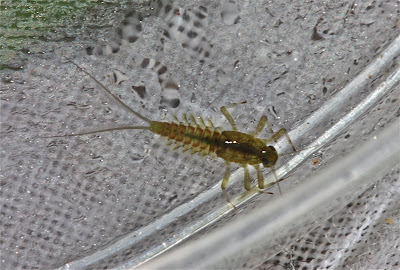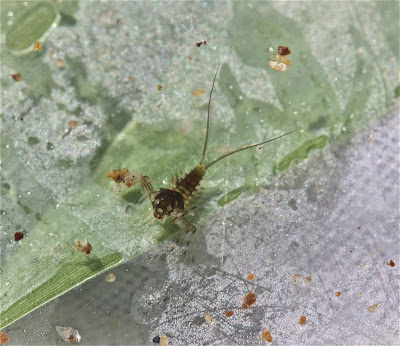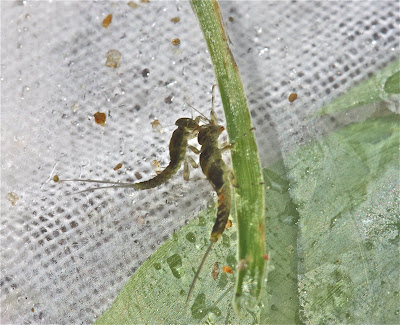Not a small minnow mayfly of course -- but we have to start with this nymph. A "Broad-winged" damselfly (Calopterygidae) -- the first one I've seen this season. Some are brown; some are bright green, but like other aquatic insects, they seem to turn dark brown and dark green as they mature. The trait we use to ID this particular family is the nature of the antennae: "First antennal segment as long as, or longer than, [the] remaining segments combined" (Peckarsky, p. 45). If you click on the photo to enlarge it, this feature ought to be clear. Another look at this lovely insect.
It is not my ambition to identify Odonata to the level of genus -- but, for those of you who work on these things, this would seem to be Hetaerina (the prementum cleft does not extend beyond the bottoms of the palpal lobes.) (See Peckarsky, pp. 46-47.)
Now, on to the theme of the entry -- there were small minnow mayflies all over the bottoms of rocks in the Moormans (near Free Union). All different colors and sizes, and if I'm right, while most were genus Acentrella, there was a Heterocloeon among them, and one tiny Baetis.
Let's look at the "odd" ones first.
Why do I think this one is genus Heterocloeon? Heterocloeon is one of the three genera (the others are Acentrella and one type of Baetis) with two tails. But the critical thing is to look at the gills. According to Peckarsky (p. 33), the center region of the gills has a large pigmented area. Here's a microscope view.
On the Baetis nymph -- it was a tiny one. But, it had three tails (or, following Merritt, Cummins, and Berg, p. 192) the "Terminal filament [was] well developed," and "hind wing pads were present." First, let's look at the nymph, then as a microscope view that shows the tiny hind wing pad.
But most of the small minnows I found today were, I think, genus Acentrella, based on the tests we posed in the entry posted just yesterday: 1) two tails; 2) no visible hind wing pads (with these, at least); 3) a dense row of long silky setae (hair) on the backs of the legs; and 4) no "well developed medially projecting corner" on segment 2 of the labial palps" (Merritt, Cummins, and Berg, p. 192). I did not look at the labial palps on every nymph that I brought home -- I only checked two. But believe me, the dense row of hair on the legs was present on every nymph. What follows are some of the best photos I got of the Acentrella nymphs. I had one that was very, very small -- it's the one with the dark wing pads -- i.e. it's close to hatching.
...and one more












No comments:
Post a Comment